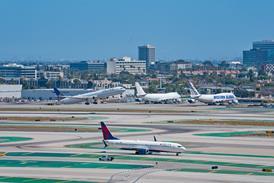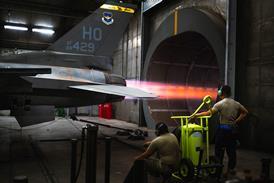As safety improves in other sectors the helicopter industry lags behind, with last year's accident figures up on 1999
David Learmount/LONDON
Steady improvement in flight safety - now a firm trend in all other sectors of the aviation industry - continues to elude the rotary-wing world. Absolute accident numbers for last year are up on those for the previous year - both worldwide, as recorded by Airclaims, and in the USA as summarised by the US authorities. The USA is by far the world's busiest helicopter operating country.
Some of that increase in numbers reflects growing sector activity, but the US Federal Aviation Administration reports that both the total and the fatal accident rates for the largest rotary-wing sector - single-engined turbine powered helicopters - also increased for last year.
In the case of piston engine-powered helicopters, US figures show that over the past five years the number of accidents and the fatal accident rate have been stable, but the total accident rate has been decreasing slightly. Piston helicopter accident rates have always been markedly higher that those for turbine helicopters (three times higher in 2000). The Helicopter Association International says that the reason for this is that pistons are used for most initial training and are flown by a relatively high proportion of entry-level pilots.
Airclaims documents 225 turbine helicopter accidents last year, of which 65 were fatal. The FAA says that 116 turbine helicopter accidents and 25 fatal events happened in the USA last year. Laos saw the the most catastrophic rotary wing crash of the year when a Mil Mi-8 hit high ground in bad weather killing all 18 people on board (see accident tables, 23 June), but Switzerland also suffered a disastrous accident involving two chartered sightseeing flights which collided on approach to the football field from which they were operating. The collision killed seven people in the aircraft and eight on the ground (26 September).
The maintenance factor
Seventy accidents were caused by some form of technical/mechanical failure, either engine (32 events), rotor (26) or other components (22). At least eight of these were clearly caused by maintenance error, but exactly how many were maintenance related will only be known when the full inquiries have been completed. Several serious accidents occurred during the post-maintenance check flight itself (18 December), and in the case of 27 other accidents it is not possible, at this stage, even to speculate intelligently on what the cause might have been.
A salutary example of how important it is for manufacturers to design critical components to be "murphy-proof" (only able to be assembled in the correct manner) is contained in two non-fatal accidents involving Agusta A109E helicopters in the UK (14 January and 17 June). Operated by different companies on different routes, both helicopters lost control when the swash plate scissors link attachment bolt fractured. Less than five flying hours before the accident, in both cases, the scissors links had been incorrectly assembled with the links positioned back to front, the investigators report. In earlier versions of the 109 it was not possible to install the part wrongly because of asymmetric component design. Also, the investigators found, the maintenance manual gives inadequate guidance for component assembly, so it is not surprising that the errors occurred.
In the hierarchy of causal factors during 2000, pilot error or misjudgment was present in 78 cases (inquiries may reveal more); loss of control came second with 43, then engine failure/power loss (32), main or tail rotor failure (32) and "other mechanical failure" (26). Other individual factors come well below these. Last year was not out of the ordinary in this respect, and as usual pilot error or loss of control was often combined with technical failure. Comparing this causal hierarchy with that for fixed-wing flying shows that pilot factors are present in a lower percentage of events - about 33% compared with about 65%. That is not necessarily to helicopter pilots' credit, but tends to confirm helicopters' dependence on more mechanically complex systems for their fundamental control functions, so system failures cause a far higher percentage of accidents than in the fixed wing case. In both aircraft categories, pilots can be disorientated by the loss of visual cues (4 February) and lose control, but helicopters' natural instability in all flight phases means that loss of control following many different circumstances is an accident cause, or at least a resulting state of affairs, in more cases than fixed wing accidents.
Recurring categories
Particular accident categories seem to recur each year with a regularity suggesting that there is a case for investigating the human factors and the operating and maintenance procedures associated with them. These accidents include:
Wire-strikes during police car chases (5 February) or medical evacuation flights attending a road accident. Telephone wires and power cables are more usually present near roads than elsewhere, so they should not be a surprise; Accidents near mountain ridges (20 July): not just those where the aircraft flies into the ridge, but where the pilot loses control in windshear near the ridge. Since windshear and sudden visibility change near ridges is a known phenomenon, there is a case for avoiding landing on or near them; Engine failure or power loss during logging operations (29 January, 1 April, 9 September). Although the past two years have shown a reduction in the numbers of long-line snagging incidents and other events directly associated with the picking up and setting down of an external load, the number of engine failures during logging may reflect the high stress cycle on engines, gearboxes, rotors and rotor drive systems caused by continually picking up and dropping heavy loads during each sortie. Perhaps the parts crucial to power and control system in helicopters used for logging should be more stringently lifed than those in other types of operation. Another factor which could be examined is that logging areas are often particularly unfriendly to the pilot who is forced to look for an instant emergency landing site. The pilots of fish-spotting helicopters and others operating from ships (4 February) are sometimes caught out by the paucity of visual cues providing perspective and height above the surface when operating over the sea, and also when making the transition to taking visual cues from the vessel and helideck for landing. This seems to be less common in pilots who operate from oil rigs and fixed platforms. Comparing the more formal training which oil company pilots usually get with that provided for other pilots operating in a marine environment could prove to be a fruitful area of study; The loss of visual cues when flying over a snow or ice-covered area (29 March), but not necessarily in poor visibility: this produced an extraordinary series of accidents in 1999 where three helicopters from the same company crashed in white-out conditions on the same day. The second and third had gone to rescue the crews on the earlier departure.The kinds of operations that helicopters perform are often those which cannot be carried out at all by other means of transport, and they certainly often go where other forms of transport cannot go. For that reason safety comparisons with fixed-wing flying have to be made with caution. But with fixed-wing flying the authorities in the major aviating nations (or blocs in the case of North America and Europe) have developed priorities lists to reduce the accidents which put passengers and crews most at risk. Controlled flight into terrain (CFIT) is at the top of the fixed-wing priorities list. CFIT affects helicopters too, but it is not the greatest killer.
Given the number of identifiable recurring helicopter accident categories the regulators would do well to work with the industry to produce its own priorities list.
Source: Flight International























